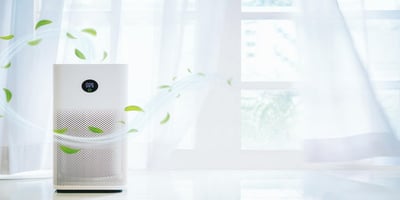How to Get Rid Of Bad Smell From Air Conditioners? Useful Advice
Ensuring a fresh and odor-free indoor environment is essential for maintaining a healthy and comfortable home. Unpleasant odors not only diminish the quality of the air we breathe but also impact our overall well-being and enjoyment of living spaces. Among the most common culprits contributing to indoor odors are air conditioners, which, despite their cooling benefits, can sometimes emit musty or foul smells. These odors often result from mold, mildew, accumulated dust, or stagnant water within the air conditioning system. However, fret not! In this article, we'll delve into effective solutions to tackle these odors head-on, ensuring a revitalized and pleasant atmosphere in your home.
Understanding the Causes of Bad Smell
Air conditioners can emit unpleasant odors due to various factors, each of which contributes to the overall discomfort and potential health risks associated with indoor air pollution.
Mold and Mildew
Mold and mildew thrive in moist environments, making air conditioners an ideal breeding ground, especially in humid climates or when there's excess moisture buildup within the system. These fungi release volatile organic compounds (VOCs) as they grow, emitting a musty odor that can permeate the air circulated by the AC unit. Inhalation of mold spores and VOCs can trigger allergic reactions, and respiratory issues, and exacerbate existing conditions like asthma.
Stagnant Water
Stagnant water within the air conditioning system, such as in drip pans or condensate drain lines, can become contaminated with bacteria and algae over time. As bacteria multiply and decompose organic matter present in the water, foul-smelling gases like hydrogen sulfide are released, resulting in a foul odor. Exposure to airborne bacteria exhaust fumes and their byproducts may pose health risks, including respiratory infections and allergic reactions.
Accumulated Dust and Debris
Dust, dirt, and other debris can accumulate on the evaporator coils, condenser coils, and air filters of the AC unit, creating a breeding ground for bacteria and mold. As the air conditioner operates, these contaminants can be circulated throughout the indoor environment, emitting a stale or dust odor. Inhalation of airborne particles can irritate the respiratory system, exacerbate allergies, and contribute to indoor air pollution.
Regular Maintenance Tips
Cleaning or Replacing Filters:
- Clean or replace air filters regularly to prevent dust, dirt, and debris from accumulating and circulating throughout your home.
- For reusable filters, clean them every 1-2 months, while disposable filters may need replacement every 1-3 months, depending on usage and air quality.
Inspecting Drip Pans:
- Check drip pans for standing water or microbial growth, as stagnant water can foster mold and mildew.
- Clean drip pans periodically to remove any buildup and ensure proper drainage, especially during humid seasons or in high-moisture environments.
Clearing Debris from Vents and Ducts:
- Remove obstructions such as dust, pet dander, or debris from vents and ducts to maintain unimpeded airflow.
- Use a vacuum with a brush attachment or a damp cloth to clean vent covers and duct openings regularly.
Cleaning Evaporator and Condenser Coils:
- Inspect evaporator and condenser coils for dirt and grime buildup, which can impair heat exchange efficiency and contribute to odors.
- Clean coils annually or as needed using a soft brush or coil cleaner to remove dirt and debris, ensuring optimal airflow and cooling performance.
Checking Refrigerant Levels:
- Monitor refrigerant levels to ensure they are within the manufacturer's recommended range.
- Low refrigerant levels can indicate leaks or system malfunctions, leading to inefficiencies and potential odor problems.
Maintaining Proper Drainage:
- Ensure condensate drain lines are clear and free of blockages to prevent water backup and microbial growth.
- Use a mixture of bleach and water to flush drain lines periodically and inhibit mold and algae growth.
Deep Cleaning Techniques
When stubborn odors persist in your air conditioning unit, deep cleaning becomes essential to eradicate them effectively. Follow these step-by-step instructions to thoroughly clean your AC system and eliminate lingering odors:
Cleaning Evaporator and Condenser Coils. Turn off the power to your air conditioner at the circuit breaker or disconnect switch. Access the evaporator coil and condenser coils, usually located behind access panels on the indoor and outdoor units. Use a soft brush or fin comb to gently remove dirt, debris, and buildup from the coils. Be careful not to bend or damage the delicate fins. For stubborn grime, apply a commercial coil cleaner or a mixture of mild detergent and water to the coils. Let it sit for a few minutes to loosen the dirt. Rinse the coils thoroughly with water using a spray bottle or hose, ensuring all cleaner residue is removed. Allow the coils to dry completely before reassembling the unit.
Removing Mold and Mildew. Inspect the interior components of your air conditioner for signs of mold and mildew growth, particularly in drip pans, drain lines, and other damp areas. Mix equal parts of water and vinegar or hydrogen peroxide in a spray bottle. Liberally spray the affected areas with the cleaning solution and let it sit for at least 15-20 minutes to kill mold and mildew. Scrub the surfaces with a brush or sponge to remove stubborn mold stains and buildup. Rinse thoroughly with water and wipe dry with a clean cloth.
Disinfecting Drip Pans and Drain Lines. Remove the drip pan from the air conditioner and empty any standing water or debris. Use a mixture of bleach and water (1:1 ratio) to disinfect the drip pan and drain line. Pour the solution into the pan and let it sit for 15-20 minutes. Scrub the pan and drain line with a brush to remove any mold, algae, or bacterial growth. Flush the drain line with clean water to remove residual bleach solution. Allow the drip pan and drain line to dry completely before reinstalling them in the unit.
Using Natural or Commercial Cleaning Agents:
- Consider using natural cleaners like vinegar, baking soda, or hydrogen peroxide for environmentally-friendly alternatives.
- Commercial coil cleaners and disinfectants specifically formulated for HVAC systems are also effective in eliminating odors and microbial growth.
- Ensure proper ventilation when using cleaning agents and follow manufacturer instructions for safe and effective application.
Odor Removal Solutions
Dealing with unpleasant odors from your air conditioner can be a hassle, but there are several effective methods for neutralizing and eliminating these smells. Here's how you can tackle the burning smell issue and keep your indoor environment fresh:
Odor-Absorbing Materials:
- Baking Soda: Place shallow bowls of baking soda near the air conditioner or in areas where odors are prevalent. Baking soda naturally absorbs and neutralizes odors, leaving the air smelling clean and fresh.
- Activated Charcoal: Utilize activated charcoal sachets or bags placed strategically around the air conditioner or in rooms with persistent odors. Activated charcoal has a porous structure that traps odors and pollutants, effectively removing them from the air.
- Vinegar: Mix equal parts water and white vinegar in a spray bottle and mist the air around the air conditioner. Vinegar's acidic properties help break down and neutralize odors, leaving behind a neutral scent.
Air Purifiers:
- Consider investing in an air purifier equipped with activated carbon filters to effectively remove odors and airborne contaminants from the indoor air. Air purifiers work by continuously circulating and filtering the air, capturing and neutralizing odors for a fresher environment.
- Look for air purifiers with HEPA filters for comprehensive filtration of allergens, dust, and other airborne particles, in addition to odor removal capabilities.
Odor-Neutralizing Sprays:
- Use commercial odor-neutralizing sprays or air fresheners designed specifically to target and eliminate odors from air conditioning units and surrounding areas. These sprays contain ingredients that bind to and neutralize odor molecules, effectively eliminating them from the air.
Preventative Measures
Preventing future odor issues in your air conditioner is essential to maintain a fresh and healthy indoor environment. Here are some tips to help you avoid odors from developing in your air filter the first place:
Regular Maintenance:
- Stick to a regular maintenance schedule for your air conditioning unit. This includes cleaning or replacing air filters, inspecting drip pans and drain lines, and clearing debris from vents and ducts.
- Schedule professional HVAC maintenance at least once a year to ensure that your system is operating efficiently and to catch any potential issues before they escalate into odor problems.
Control Moisture:
- Keep humidity levels in check to prevent mold and mildew growth. Use a dehumidifier if necessary, especially in areas prone to high humidity.
- Promptly address any leaks or moisture buildup around the air conditioner to prevent water from collecting and creating a breeding ground for odor-causing bacteria and fungi.
Proper Ventilation:
- Ensure adequate ventilation throughout your home by opening windows and using exhaust fans in kitchens, bathrooms, and laundry rooms.
- Allow fresh air to circulate regularly to prevent stagnant air and remove indoor pollutants, including odors, from your living space.
Address Odors Promptly:
- Don't ignore strange or foul smells coming from your air conditioner. Investigate and address the source of the odor as soon as possible to prevent it from worsening.
- If you notice persistent odors despite regular maintenance, consider contacting a professional HVAC technician to inspect and troubleshoot the issue.
Use Odor-Absorbing Materials:
- Proactively use odor-absorbing materials like baking soda, activated charcoal, or sachets filled with natural odor-absorbing agents near the air conditioner or in areas prone to odors.
- Replace these materials regularly to maintain their effectiveness in neutralizing odors and keeping your indoor environment fresh.
Encourage Regular Maintenance Routines And Prompt Attention To Any Signs Of Odor Development.
Regular maintenance is key to keeping your air conditioner running smoothly and odor-free. Make it a habit to schedule routine inspections and cleanings to ensure optimal performance and your central air conditioner smells and quality. Additionally, pay close attention to any signs of odor development, as they could indicate underlying issues that need to be addressed promptly. By staying proactive and addressing problems early on, you can prevent odors from worsening and maintain a fresh and comfortable indoor environment for you and your family.
Maintaining Proper Ventilation And Humidity Levels To Inhibit Mold And Mildew Growth.
Proper ventilation and humidity control are essential for preventing mold and mildew growth, which can contribute to unpleasant odors in your air conditioner. Here's how to maintain optimal indoor and air conditioner smell quality.
- Use Exhaust Fans. Utilize exhaust fans in bathrooms, kitchens, and laundry rooms to remove excess moisture from the air. Run these fans during and after activities that generate steam or humidity, such as showering or cooking, to prevent moisture buildup.
- Increase Natural Ventilation. Open windows and doors whenever weather permits to allow fresh air to circulate throughout your home. Cross-ventilation helps reduce humidity levels and refreshes indoor air, minimizing the risk of mold and mildew growth.
- Use a Dehumidifier. Install a dehumidifier in areas prone to high humidity, such as basements or crawl spaces. Set the dehumidifier to maintain indoor humidity levels between 30-50%, as recommended by the Environmental Protection Agency (EPA), to inhibit mold and mildew growth.
- Maintain Air Conditioner Settings. Ensure that your air conditioner is set to an appropriate temperature and humidity level to prevent excessive moisture accumulation. Avoid setting the thermostat too low, as this can lead to condensation on surfaces and promote mold growth.
- Insulate and Seal. Properly insulate and seal windows, doors, and other openings to prevent outdoor humidity from infiltrating your home. Additionally, insulate air ducts to prevent condensation and mold growth inside ductwork.
- Monitor Indoor Humidity. Use a hygrometer to monitor indoor humidity levels regularly. If humidity levels consistently exceed 50%, take steps to reduce moisture sources and improve ventilation to prevent mold and mildew growth.
In conclusion, maintaining a fresh and comfortable indoor environment hinges on proactive maintenance and regular cleaning of your air conditioner. Throughout this article, we've highlighted the importance of addressing common issues such as mold, mildew, and stagnant water to prevent unpleasant odors and smells from permeating your living space. By staying vigilant and adhering to a consistent maintenance schedule, you can effectively keep your air conditioner odor-free and ensure optimal performance.
Remember, the solutions provided here—from using odor-absorbing materials like baking soda and activated charcoal to investing in air purifiers—are accessible and effective ways to combat odor problems. Implementing these strategies not only improves indoor air quality but also contributes to a healthier and more enjoyable living environment for you and your family.
In light of these considerations, I encourage you to take action and incorporate the suggested maintenance routines and odor removal solutions into your household practices. By doing so, you'll not only safeguard against unpleasant odors but also enhance your overall quality of life. Here's to enjoying a fresh and comfortable indoor environment year-round.






































.png?height=200&name=image_2024-07-11_20-09-51%20(1).png)